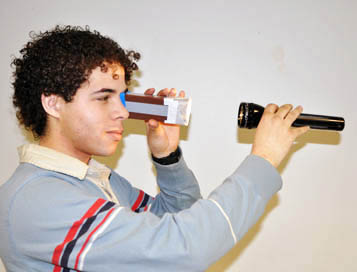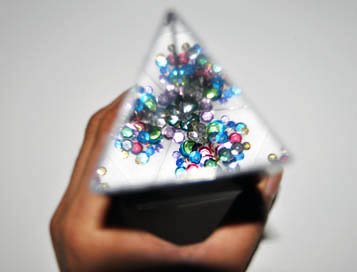|
Teach
With Bigshot |
Build a KaleidoscopeNext
Prev
When you twist a kaleidoscope, incredible formations of color emerge one after another. As beautiful as they are, kaleidoscopes are quite easy to make. Try building one for yourself by following these instructions. Things You Need
Three small mirrors

Construction paper

Tracing paper

Small, fun objects

Flashlight

Scissors

Tape

Pencil
(Touch or hover over each item for more information or alternatives)
How To Make ItThings To Try
Point your kaleidoscope towards the flashlight or other light source and look through the hole in the construction paper. You should see a large pattern of reflected objects. 
Rotate the kaleidoscope to rearrange the objects and create a new pattern. How It WorksMirrors work by reflecting light. When you look at an object's reflection through a mirror, the reflection looks as if it is located exactly where the object would see it if the object was able to see through the mirror. That is, the mirror itself becomes a line of symmetry between the object's actual location and the reflection that you see. If two or more mirrors are angled towards each other, the reflection itself may have a reflection with respect to the second mirror, and multiple images of the object can be seen.  For the viewer located at the bottom of the figure above, the reflection of the object looks as if it is located at the blue star, the mirror image of the object itself with respect to the horizontal mirror. The green star is the mirror image of that first reflection with respect to the diagonal mirror, and the object has a second reflection when the viewer looks into the diagonal mirror. In your kaleidoscope [1], light reflects off the three mirrors dozens of times, leading to dozens of reflections of the objects inside. The section of a kaleidoscope that holds the small objects inside is called the object cell. The entire interior of your kaleidoscope acts as its object cell, but many kaleidoscopes have a piece of glass or clear plastic that holds the objects inside next to the end where the light shines through. Fun FactsKaleidoscope EtymologyThe word "kaleidoscope" comes from three Greek words: kalos ("beautiful"), eidos ("shape"), and skopeo ("to observe"). Together, they mean "observer of beautiful forms". Kaleidoscopes were invented by Sir David Brewster, an English scientist, in 1816. TeleidoscopesA teleidoscope [2] is, as its name suggests, a cross between a kaleidoscope and telescope. It features a long tube of mirrors, but the tube is empty and has a hole at the far end so people can see straight through. Some have lenses at the far end to block objects from entering the tube. Kaleidoscopes allow people to view reflections of objects stored inside, but teleidoscopes allow people to see reflections of objects that are outside. Fractals
The patterns that you see when looking through a kaleidoscope bear a striking resemblance to fractals. Fractals [3] are geometric shapes that can be split into smaller versions of the same shape. Those pieces can be split into even smaller versions of the same shape, and those pieces can be split even further into the same shape, and so on. The animation at left shows the first seven steps for creating a very famous fractal called the Koch snowflake. The King of KaleidoscopesThe world’s largest kaleidoscope [4], located in Mount Tremper, New York, is a converted grain silo that is over 56 feet tall. There are three tapered mirrors housed inside that are 37 feet long and weigh 2.5 tons. A seasonal video complete with a musical score is played inside.

|
| [1] | "Kaleidoscope." Wikipedia, The Free Encyclopedia. [Online]. Available: http://en.wikipedia.org/wiki/Kaleidoscope. [Accessed: Jan 20, 2013]. |
| [2] | "Teleidoscope." Wikipedia, The Free Encyclopedia. [Online]. Available: http://en.wikipedia.org/wiki/Teleidoscope. [Accessed: Jan 20, 2013]. |
| [3] | "Fractal." Wikipedia, The Free Encyclopedia. [Online]. Available: http://en.wikipedia.org/wiki/Fractal. [Accessed: Jan 20, 2013]. |
| [4] | "The World's Largest Kaleidoscope." [Online]. Available: http://www.kaleidostore.com/largest.htm. [Accessed: Jan 20, 2010]. |
| [5] | N. Ardley, 101 great science experiments. DK Publishing, 2006 |







 References
References